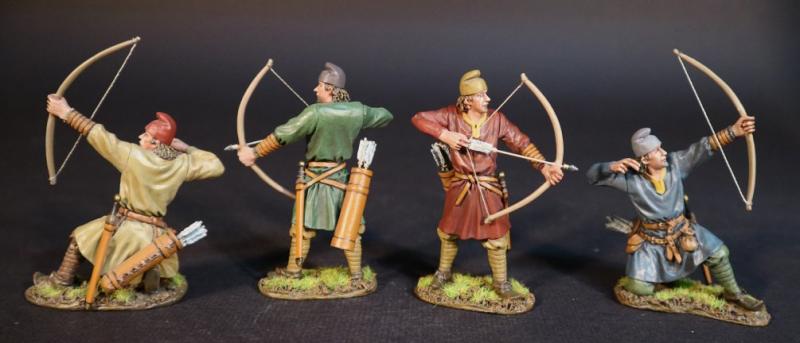Four Saxon Archers (2 standing ready to loose, 2 kneeling having loosed), Angla Saxon/Danes, The Age of Arthur--four figures
$160.00
Item Number: SX-69N
Four Saxon Archers (2 standing ready to loose, 2 kneeling having loosed), Angla Saxon/Danes, The Age of Arthur
THE AGE OF ARTHUR
THE BATTLE OF HASTINGS 1066
The Battle of Hastings took place on the 14th October 1066. Although the numbers on each side were about equal, William had the advantage of having both cavalry, infantry, and many archers. Harold had only foot soldiers, and few archers. The English formed a shield wall along a ridge, and were initially so effective that the invading Norman army was repeatedly thrown back with heavy casualties.
ANGLO SAXON ARCHERS
Many different weapons were created and used in Anglo-Saxon England between the fifth and eleventh centuries. Spears, used for thrusting and throwing, were the most common weapon. Other commonplace weapons included the sword, axe, and knife.
Weapons also had symbolic value for the Anglo Saxons, apparently having strong connections to gender and social status. Weapons were commonly included as grave goods in the early Anglo-Saxon burials. The vast majority of these weapons were buried in graves of men, but they were also buried in the graves of women. In a non funerary context, weapons were occasionally deposited in the ground or near rivers.
The establishment of a literate Christian clergy in Anglo Saxon England resulted in the production of several textual sources that describe weapons and their use in battle.
Artistic depictions of soldiers bearing weapons can also be found in some Anglo Saxon sculpture. Depictions also appear in manuscript illustrations and of course in the embroidered Bayeux Tapestry. However, the artists may have been following artistic conventions concerning the depiction of warriors and weapons rather than accurately portraying the use of such items in their society.
It is accepted that Anglo Saxons primarily used the bow to hunt, and therefore it is believed that most men would have been skilled in its use.
Examples of Anglo Saxon archery equipment are rare. Iron arrowheads have been discovered in approximately 1% of early Anglo Saxon graves, and traces of wood from the bow stave are occasionally found in the soil of inhumations. Although rarely found in graves, bows appear more frequently in Anglo Saxon art and literature. On the eight century Northumbrian Franks Casket, an archer is shown defending a hall from a group of warriors.
There are 29 archers depicted on the eleventh century Bayeux Tapestry. Only one of these is an Anglo Saxon archer, the remainder are Norman.
Released in FEBRUARY 2024.

